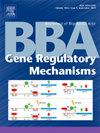RhoA functionally collaborates with HSPA1A to promote the migratory phenotype of cancer cells
IF 3.1
3区 生物学
Q3 BIOCHEMISTRY & MOLECULAR BIOLOGY
Biochimica et Biophysica Acta-Gene Regulatory Mechanisms
Pub Date : 2025-06-20
DOI:10.1016/j.bbagrm.2025.195101
引用次数: 0
Abstract
RhoA, a member of the GTPase family, plays a pivotal role in attaining a migratory phenotype, mainly by regulating cytoskeleton dynamics, cell adhesion and membrane protrusions. Although many upstream regulators and downstream effectors of RhoA have been identified, the discovery of new interacting partners continues to expand its interactome, providing fresh insights into its regulation and function. Co-immunoprecipitation and fluorescence microscopy were used to study the interaction, localization and morphological effects of HSPA1A and RhoA. The interaction was validated by modulating the protein expression through transfections and silencing approaches. Cell proliferation, migration and viability were assessed using MTT, a Boyden chamber and FACS assays, respectively. Our study identified HSPA1A, as an unexplored interacting partner of RhoA under physiological conditions. Functional analyses showed that the interaction between HSPA1A and RhoA enhances the migratory potential of cancer cells, induces G0/G1 cell cycle arrest and promotes a rounded cell morphology. Under HSPA1A transfection, increased RhoA protein levels were observed, while the silencing of HSPA1A resulted in decreased RhoA levels. This study highlights the critical role of HSPA1A-RhoA interaction in regulating cancer cell migration, morphology and cell cycle progression. These findings lay the groundwork for future research into its potential clinical applications.
RhoA与HSPA1A在功能上协同促进癌细胞的迁移表型
RhoA是GTPase家族的一员,主要通过调节细胞骨架动力学、细胞粘附和膜突出在迁移表型的实现中起关键作用。虽然RhoA的许多上游调控因子和下游效应因子已经被确定,但新的相互作用伙伴的发现继续扩大其相互作用组,为其调节和功能提供了新的见解。采用免疫共沉淀法和荧光显微镜技术研究HSPA1A和RhoA的相互作用、定位和形态效应。通过转染和沉默方法调节蛋白表达,验证了这种相互作用。分别采用MTT、Boyden室和FACS法评估细胞增殖、迁移和活力。我们的研究发现HSPA1A在生理条件下是RhoA的一个未被探索的相互作用伙伴。功能分析表明,HSPA1A与RhoA的相互作用增强了癌细胞的迁移潜能,诱导G0/G1细胞周期阻滞,促进细胞形态呈圆形。转染HSPA1A后,RhoA蛋白水平升高,而沉默HSPA1A导致RhoA蛋白水平降低。本研究强调了HSPA1A-RhoA相互作用在调节癌细胞迁移、形态和细胞周期进程中的关键作用。这些发现为进一步研究其潜在的临床应用奠定了基础。
本文章由计算机程序翻译,如有差异,请以英文原文为准。
求助全文
约1分钟内获得全文
求助全文
来源期刊
CiteScore
9.20
自引率
2.10%
发文量
63
审稿时长
44 days
期刊介绍:
BBA Gene Regulatory Mechanisms includes reports that describe novel insights into mechanisms of transcriptional, post-transcriptional and translational gene regulation. Special emphasis is placed on papers that identify epigenetic mechanisms of gene regulation, including chromatin, modification, and remodeling. This section also encompasses mechanistic studies of regulatory proteins and protein complexes; regulatory or mechanistic aspects of RNA processing; regulation of expression by small RNAs; genomic analysis of gene expression patterns; and modeling of gene regulatory pathways. Papers describing gene promoters, enhancers, silencers or other regulatory DNA regions must incorporate significant functions studies.

 求助内容:
求助内容: 应助结果提醒方式:
应助结果提醒方式:


